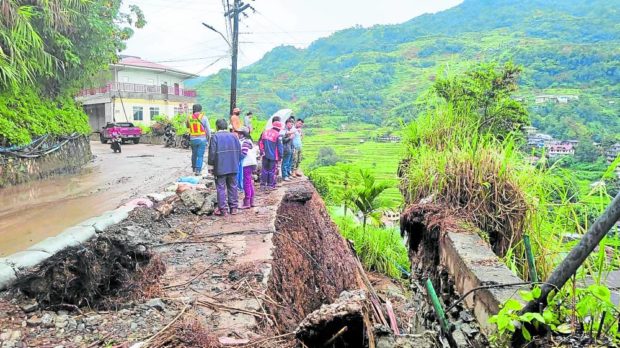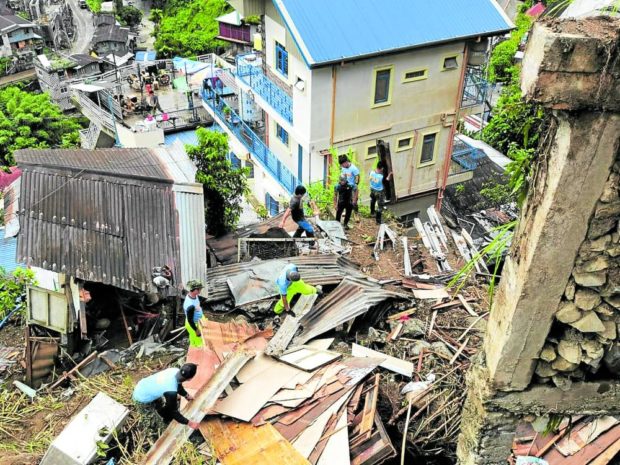‘Weak’ slopes worsened Banaue floods – DPWH

ROAD DAMAGE | A section of a road at Barangay Poblacion in Banaue, Ifugao, has collapsed after flash floods triggered by heavy rains hit the tourist town last week. (Photo courtesy of the 2nd Ifugao Provincial Mobile Force Company)
BAGUIO CITY, Benguet, Philippines — A team from the Japan International Cooperation Agency (Jica) studied the vulnerability of Ifugao roads to slope failure days before the strong rains triggered landslides and flash floods that hit its tourist town of Banaue, an official of the Department of Public Works and Highways (DPWH) said on Wednesday.
Jica was exploring a joint project with the DPWH to stabilize mountains surrounding Ifugao towns a week before the tragedy struck on July 7, according to Angie Mabitazan, the DPWH Cordillera spokesperson, on the sidelines of a regional development council briefing.
Flash floods rolled down Banaue’s main streets and swamped the town center due to strong rains, inundating more than a thousand homes and shops, and injuring six residents who were given first aid.
Vulnerable
Ifugao has been open to tourists since restrictions due to COVID-19 were eased, although the province remains under alert level 2, except for the towns of Lagawe, Kiangan and Lamut, which are under alert level 1, the least restrictive in a five-tier alert system.
But the floods were caused by a collapsed mountain slope and were not due to broken or insufficient drains, said Mabitazan, one of the agency’s planning engineers.
“We have been aware of [sections of] mountains that may be weak and could [collapse] if pummeled by strong rains,” she said, noting it was the reason why the Jica project was being worked out.
Jica experts visited the vulnerable roads around Mt. Polis a week before the landslides hit Banaue to explore engineering solutions and prevent erosion, said Edward Cariño, Ifugao district maintenance engineer, in a telephone interview on Wednesday.
The DPWH Ifugao office has not yet been given details about the volume of rainfall last week, which affected the villages of Amganad, Bocos, Gohang, Poblacion, Poitan, San Fernando, Uhaj, Tam-an and Viewpoint, he said.
Engineers were also assessing the full extent of the damage to Banaue, the home of two clusters of the province’s rice terraces, which have been designated collectively as one of the country’s World Heritage Sites by the United Nations Educational, Scientific and Cultural Organization.

CLEARING | Policemen and disaster response personnel on Wednesday clear debris left by flash floods and landslides that hit houses and roads at Sitio Pangngat in Banaue, Ifugao, last week. (Photo courtesy of the 2nd Ifugao Provincial Mobile Force Company)
Clogged drains
Old postcards showing the terraces are of the Batad terraces in Banaue, which were the subject of restoration more than a decade ago.
Debris from two roads—along the boundaries of the provinces of Nueva Vizcaya, Ifugao and Mountain Province and along the borders of Banaue and Hungduan towns—“clogged the drains, which worked perfectly in past monsoon seasons,” Cariño said.
Around 8 kilometers of the 10-km section on the Ifugao side of the Nueva Vizcaya road suffered erosion, while landslides obstructed portions of the Banaue road, which also stretches 10 km, he said.
According to Cariño, initial repair estimates would require P50 million to rebuild and improve slope protection and P3 million to cover clearing and hauling debris.
—VINCENT CABREZA
RELATED STORIES
NDRRMC: Over 1,00 families displaced, 6 injured in Banaue flash floods
Damage to agriculture in flood-hit Banaue reaches P48.8M
Roads to Banaue now passable; tourist activities remain halted — DOT